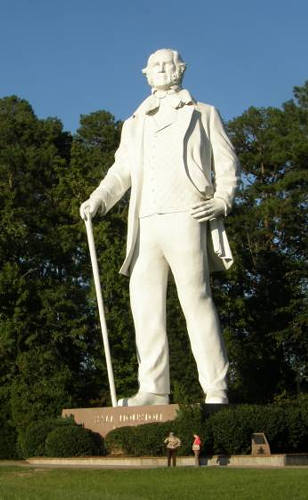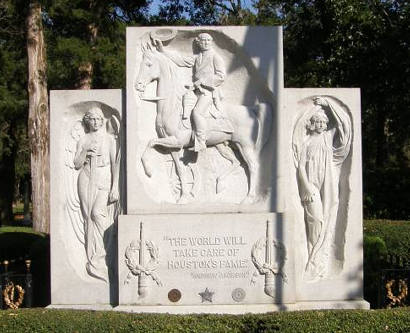|
The
old Texas Rangers who gathered in Austin
for a reunion in the early fall of 1897 surely figured they had fought
their last fight. After all, they had battled and survived Mexican
soldiers, Comanches and outlaws. But that’s before they heard what
some folks in Tennessee were up to.
Meeting in the Capital City on the night of October 8, the aging rangers
got word that certain parties in the Volunteer State were agitating
for the removal of Sam
Houston’s remains from Texas to his
old stomping grounds in Tennessee. Some of the old rangers had known
Houston. The others all knew of his place in their state’s history.
Houston came to Texas in 1832 following
a drunken sabatical among the Cherokees in what is now Oklahoma. Before
then, he had served as governor of Tennessee, his political career
there ending concurrently with his short-lived first marriage. Only
four years after crossing the Red River, having assured Texas’ independence
from Mexico by defeating Gen. Antonio Lopez de Santa Anna at San
Jacinto, Houston became the first president of the new Republic
of Texas. |
 |
|
He lived to
see Texas admitted as the 28th state
in 1845, dying at 70 of natural causes on July 26, 1863 during the
bloody Civil War he had tried to avert. His family abided by his
wishes and buried him in Oakwood
Cemetery in Huntsville,
the Walker County
town he and his wife Margaret had settled in because it reminded
him of his boyhood home in Tennesse.
But
33 years after his death, the sentiment had risen in Tennessee that
Houston should be exhumed from his Texas grave and shipped “home”
to the hills of his youth. The former rangers gathered for comradery
in Austin learned of this
idea in a letter from Marie Bennet Urwitz, president of the Cuero-based
San Jacinto Chapter of the Daughters of the Republic of Texas and
the daughter of a former ranger.
Mrs. Urwitz
wrote that “a proposition has been made the family of Gen. Houston
for the removal of the remains of that immortal chieftain from Texas
to Tennessee.”
She continued, “I hope your patrioic and venerable body will offer
a strong protest against any such proposition. A state which would
allow [Houston’s removal] is not worthy of the grave of [Ben]
Milam, Bowie, Travis or the memory of such a man as your [former
Ranger captain] Jack
Hays.”
The
aging rangers, used to saddling up and riding hard at a moment’s
notice, acted quickly after hearing Mrs. Urwitz’ letter. Voting
unanimously, the veterans approved this resolution:
“Whereas, we have learned that there is a proposition to remove
the remains of Gen. Houston from this state to Tennessee; be it
“Resolved, that we, the ex-rangers of Texas,
are unalterably opposed to the removal of the remains of that hero
from the land of his choice and the field of his illustrious and
imperishable fame.
“Resolved, that the remains of our immortal chieftain should abide
in their final rest in the sacred soil of Texas,
which he successfully defended and that an appropriate monument
worthy of Texas should mark the grave
which will be sought by patriotic pilgrims in increasing numbers
through future ages.”
Texas newspapers of the day are silent on how it all played out,
but Houston’s remains stayed put in Huntsville.
Doubtless, most of the veteran rangers who voted for the resolution
to keep the hero of San
Jacinto in Texas would have defended
Houston’s burial place with force of arms had the movement to move
him progressed further.
|
 |
|
As
for the former rangers’ recommendation that “an appropriate monument”
be placed over Houston’s final resting place, that took a little
longer. Not until April 21, 1911 – the 65th anniversary of San
Jacinto – did assorted dignitaries show up for the dedication
of a large granite monument at Houston’s grave.
Sharing the limelight with Alonzo
Steele, the battle’s last survivor, the “Great Commoner” William Jennings Bryan gave the keynote speech at the unveiling of the massive
stone, which features a trio of bas reliefs of Houston by sculptor
Pompeo Coppini.
“It is [the] willingness to die for what one believes is right,”
Bryan said that spring day, “that makes civilization possible.”
© Mike Cox
"Texas Tales" January
13, 2011 column
See Huntsville,
Texas
|
|
|